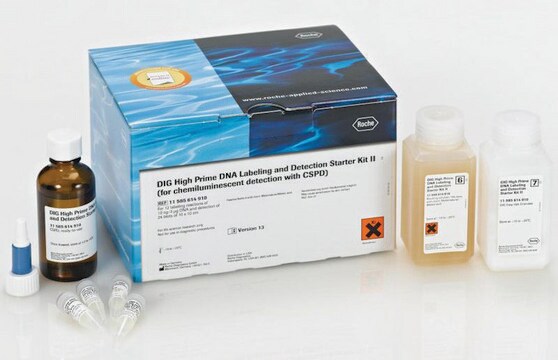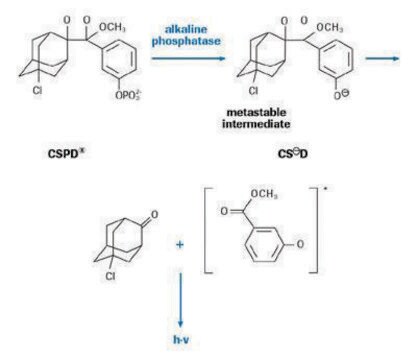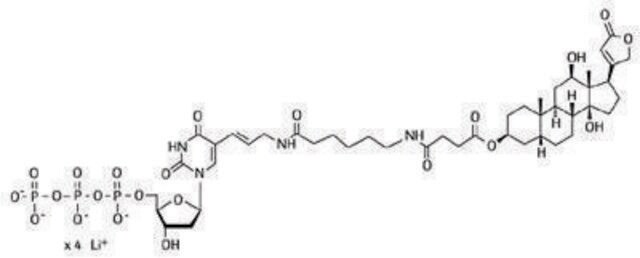Kluczowe dokumenty
11175033910
Roche
DIG DNA Labeling Kit
sufficient for 40 labeling reactions, kit of 1 (7 components), suitable for hybridization
Synonim(y):
dig, dna labeling kit, dig
About This Item
Polecane produkty
zastosowanie
sufficient for 40 labeling reactions
Poziom jakości
opakowanie
kit of 1 (7 components)
producent / nazwa handlowa
Roche
charakterystyka ekologicznej alternatywy
Designing Safer Chemicals
Learn more about the Principles of Green Chemistry.
sustainability
Greener Alternative Product
metody
hybridization: suitable
kategoria ekologicznej alternatywy
, Aligned
temp. przechowywania
−20°C
Opis ogólny
Specyficzność
Zastosowanie
- All types of filter hybridization according to our standard protocol given in the pack insert of the special hybridization solution DIG Easy Hyb.
- Single-copy gene detection in total genomic DNA, even from organisms with high complexity, for example, human, barley, and wheat.
- In situ hybridizations
Opakowanie
Jakość
Charakterystyka techniczna
Sensitivity and specificity: A single-copy human gene (tPA gene) is detected with a DIG-labeled probe in a Southern blot of 1μg digested human placenta DNA.
Zasada
Note:
- The use of the alkali-labile form of DIG-11-dUTP enables easier and more efficient stripping of blots for rehybridization experiments with a second DIG-labeled probe.
- DNA probe, labeled with DIG-11-dUTP, alkali-labile must not be denatured using NaOH, but can be denatured by boiling in a waterbath.
Inne uwagi
Tylko elementy zestawu
- Unlabeled Control DNA 1 100 µg/ml
- Unlabeled Control DNA 2 100 µg/ml
- DNA Dilution Buffer
- DIG-labeled Control DNA 5.2 µg/ml
- Hexanucleotide Mix 10x concentrated
- dNTP Labeling Mixture 10x concentrated
- Klenow Enzyme, Labeling grade 2 U/µl
Kod klasy składowania
12 - Non Combustible Liquids
Klasa zagrożenia wodnego (WGK)
WGK 1
Temperatura zapłonu (°F)
does not flash
Temperatura zapłonu (°C)
does not flash
Wybierz jedną z najnowszych wersji:
Masz już ten produkt?
Dokumenty związane z niedawno zakupionymi produktami zostały zamieszczone w Bibliotece dokumentów.
Klienci oglądali również te produkty
Produkty
Digoxigenin (DIG) labeling methods and kits for DNA and RNA DIG probes, random primed DNA labeling, nick translation labeling, 5’ and 3’ oligonucleotide end-labeling.
Metody znakowania digoksygeniną (DIG) i zestawy do sond DNA i RNA DIG, znakowanie DNA z losowym primerem, znakowanie nickiem translacyjnym, znakowanie końcowe oligonukleotydów 5' i 3'.
Nasz zespół naukowców ma doświadczenie we wszystkich obszarach badań, w tym w naukach przyrodniczych, materiałoznawstwie, syntezie chemicznej, chromatografii, analityce i wielu innych dziedzinach.
Skontaktuj się z zespołem ds. pomocy technicznej








